#isof
Photo
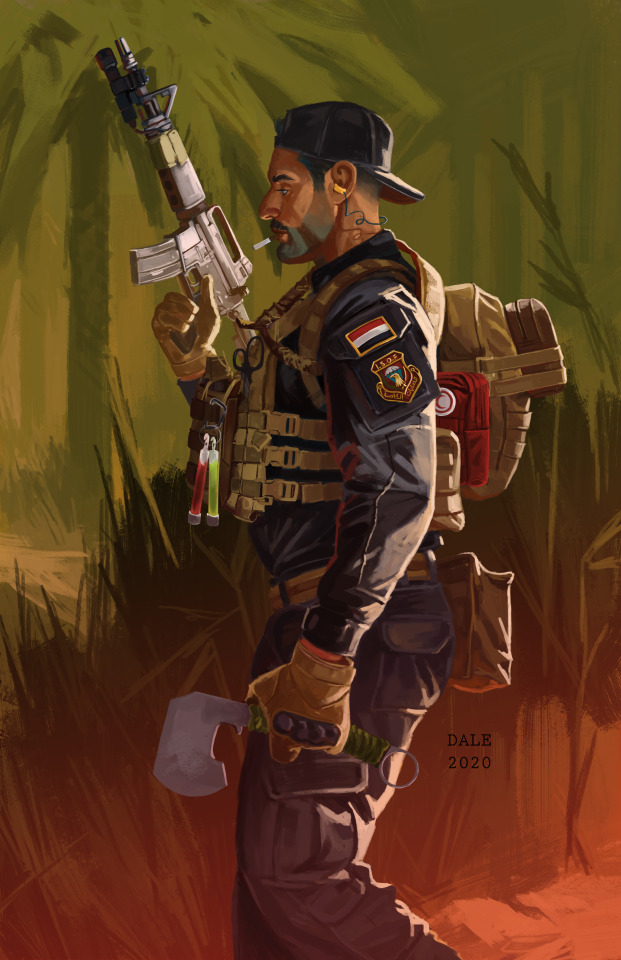

Iraqi Special Operations Forces (ISOF) Soldier
Painted in Photoshop
This was the very last illustration I painted for fun... almost two years again, man ;-;
(I should say, I had a short lived blog where I posted this illustration, but the signature reads “kodiak 2020″. I swear on every single bear that’s me, I just decided I wanted to go back to using “dale” as my signature. So if you see it floating around, please don’t think I stole someone’s art lol)
121 notes
·
View notes
Text
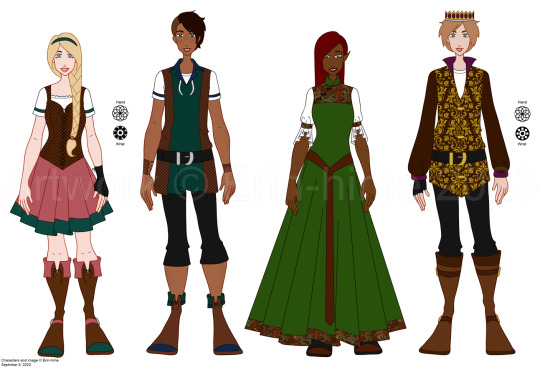
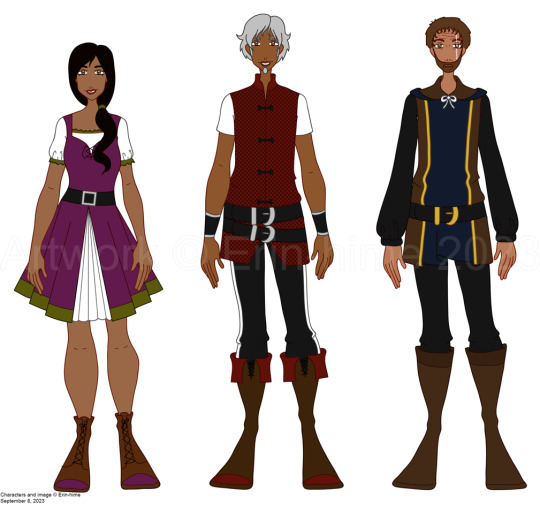
This is another case of updating designs for older stories because the older designs annoyed me. Not sure how I ended up on In Search of Freedom, but, uh, it was sort of dangerous that I did. ISoF is another story that I could potentially redo in November. I mean, it's not a crazy anniversary, but it has been five years.
Not much changes about the characters per say in this version. I mostly want to tweek the plot a little based on a few things that I would like to change since figuring out a few things about the story. You know how it goes - you imagine certain scenes for so long that you have to write them, but you realize that they don't really work? So you write them in the first draft just because, and then go back and rewrite to make everything better. I think that's what's going on with this story.
I know I've been aging people up in my other stories, but I'm not sure if I really can with this one. Illy's supposed to be young and impressionable at the start of the story, which is why she just sort of goes with the flow as everyone treats her horribly all the time. Even more so after Dracen's coronation. Fifteen seems like a good age for that. IDK, I think I'llkeep them young.
I really like Illy's new peasant design. It's simple yet cute, and very peasanty, lol. I keep staring at it in awe, I love it so much. So pretty.
Leon's design is great as well. I like the idea that their generation basically combines their old style with Artemisian style, since they all grew up as Artemisians. But they still want to retain some of their old culture. The result is something like this, and I like it.
Evangeline is one that changes the most in this version. For one thing, I decided that the elves have Asian features, and that the old Apollon style was Asian influenced because they were close with the elves. Her home life is a little less depressing and a little more tragic. The Apollons and the elves coexisted perfectly, and her parents are actually married and her father is a good and kind ruler. However, when Evangeline was five, news of Artemisia coming the annex them reached the Apollons, and Duke Edward, rather than fight and get his people hurt, decided to just hand over the town to protect the people. But the elves retreated into the forest as not to be used by the Apollons, which also included Evangeline's mother. (She's still in contact with her mother in this version, however, meeting occasionally). Prior to the start of the story, Duke Edward is sent out on a ridiculous crusade by Magnus, leaving Evangeline in charge. She's not officially a duchess, but the people refer to her as such.
As for her design, she, too, has the Apollon/Artemisia influence in her clothes, but mostly because she's forced to because of her station. I really like the hairstyle I gave her, figuring she couldn't do anything drastic with it thanks to being Artemisian nobility, but still finding a way to mimic the edgy Apollon hairstyles. I really like her design. She's pretty.
Dracen doesn't really change much, either. I took away her cloak, and it makes a world of difference, lol. I've always like his design - it looks regal. I think the biggest change I'm making to him is the fact that he's, well, not sleeping with a bunch of noble ladies each night (he's still somehow a virgin) despite Magnus' best efforts. Illy suspects something's up almost immediately after his coronation since his personality changes drastically, but she chalks it up to the stress of ruling a kingdom.
Nora, again, doesn't change. She's still Illy's handmaiden who gets teleported with her mistress to Apollon, although with Illy's undeveloped Seraph powers, she teleports them separately. Nora gets a job as a seamstress in town under Illy's insistence, which she finds she enjoys more than she wants to admit. She want nothing more than the serve Illy, however. I originally had her in something else, but it irked me that she looked higher class that Illy did, which Nora would not stand for, even if Illy was living with farmers and Nora was living in town, lol. But I like this, and I imagine that she took influence from her own place of birth as to throw people off that she's actually from the capital. She's cute - I really like this.
Davin, again, doesn't change much. There wasn't anything to change about him in the first place. I don't really have any explanation as to why his hair is silver, although maybe he has a little elf blood in him? I think I might go with that. Like with Evangeline, he can't go too crazy with anything thanks to being an Apollon Knight and needing to visit the capital every now and then. But that's fine. He grew a goatee to stick it to the man, lol.
Magnus doesn't change, either, except I gave him a beard because I pictured him with one and, lol, now he looks like Jeremy Irons and that is not a bad thing at all.
I made it a point that the Artemisian style seems to be darker than the Apollon style. I liked the thought that the were colorful to begin with, and kept that tradition, since the Artemisians never really did anything after acquiring their village.
I also included what Illy and Dracen's tattoos look like. The ones on their hands are their Seraph marks, which is why they looks exactly alike, whereas the ones on their wrists are the ones used to identify them as royals, which is why they looks similar, but are different. Its actually very unusual that Dracen has a Seraph mark at all, since males typically don't inherit the power, but his power is definitely weaker than Illy's which is why he's influenced by Magnus and she is not.
These designs are really making me want to rewrite this story, lol, since they are so shiny. So pleased with how they turned out. :D
1 note
·
View note
Text
What if I was told you that I'm about to drop you a whole-ass infodump on my oc Isof? Just look at this man! You know who he is? A wanted criminal! Tho, he didn't do anything very criminal, just slightly criminal. But oh well, big corporations don't excuse easily. Fuck around and find out what Isof had done and why he's a ghost!
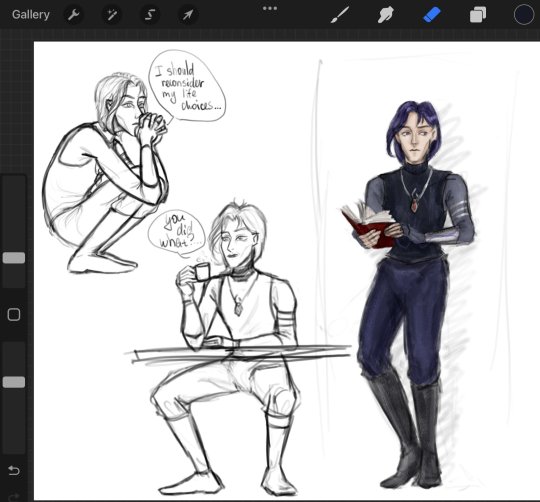
1 note
·
View note
Photo

👻 「 Happy Saint Lucy day 」 • Swipe to read the folklore behind this day and stuff that mouth of yours with a saffron bun while you’re at it! Unless you don’t like raisins. In that case, just pretend to join in on the tradition. The dark legend of Saint Lucy’s day! Do you know the dark legend of Saint Lucy’s day? Recently this Saint was celebrated all over Scandinavia and people seem to appreciate this painting I made a while back so I thought I’d share it once again! Looking forward to Christmas? Did you know, that in the middle ages, the 13th night of december was considered dangerous? It was a night were animals could speak and spirits and magical creatures were roaming the streets. Today, Scandinavia and Italy celebrate an italian martyr known as Saint Lucy (or Saint Lucia) who is said to have blinded herself but was given her sight back by god. When burnt at the stake she was not wounded but was eventually killed with a sword. Although in modern times portrayed as a saint wearing a candle lit wreath, many accounts (from the middle ages and even into the late 1900’s) describe Lucy to be a witch, an evil spirit or a leader of spirits. This is connected to her name’s similarity to ”Lucifer”, the devil himself. • ART by # Anton Vitus ( # vitusart / # AVITUS) • Sources: #wikipedia , #isof , #nordiskamuseet • #HappySaintLucyDay #saintlucysday #saintlucy #folklore #mythologyart #folkloreart #darkart #darkartandcraft #darkartist #horror #horrorart #fantasyart #characterdesign #painting #digital #traditional #notai #legend #storytime #art #folklore #saintlucy #darkart #gothic #yule #digitalart #digital #darkartandcraft #darkartist #scandinavia #christmasart #hauntedart https://www.instagram.com/p/CmT4rG0SAtm/?igshid=NGJjMDIxMWI=
#wikipedia#isof#nordiskamuseet#happysaintlucyday#saintlucysday#saintlucy#folklore#mythologyart#folkloreart#darkart#darkartandcraft#darkartist#horror#horrorart#fantasyart#characterdesign#painting#digital#traditional#notai#legend#storytime#art#gothic#yule#digitalart#scandinavia#christmasart#hauntedart
0 notes
Text

geno voice:

235 notes
·
View notes
Text
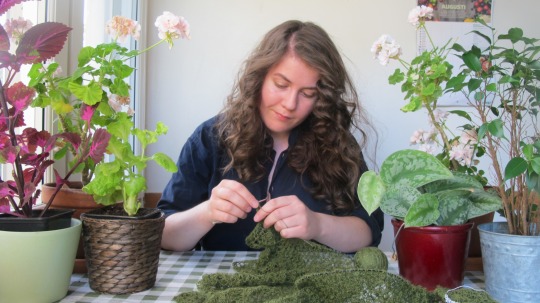
You know that feeling when your just happily crafting along and it’s going fine. The weather is the perfect kind of ambiance that you want (sunny, stormy, pattering if a soft rain idk you do you), the pattern is understandable and you’re generally enjoying yourself.
Then it happens. There’s a knot on your thread.

Now in Swedish folklore there are three (3) kinds of thread knot, depending on the situation.
Number 1: the love knot (kärleksknut).

This is a kind of knot that is easily undone. Usually the thread just went over itself and made a little slip knot that you can just tug the end of. It means someone who likes you is thinking of you and it made your thread tease you about it. Might be slightly bothersome, might also make you think of them back.
Number 2: the envy knot (avundsknut).
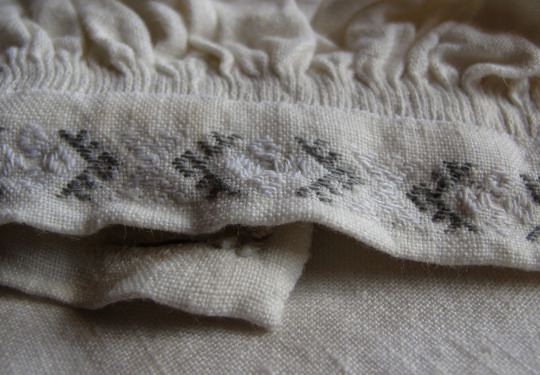
Perfection will always attract envy. The lesson is that faults in your work is not only fine, but encouraged. Lest you should draw the gaze of the evil eye, or even worse - the gods.
An envy knot in Swedish folklore is usually caused by humans who are envious of your work. It’s the kind of knot where however you pull it it won’t release and you end up making it tighter until you just cut the thread off to make a new start after it.
Number 3: the troll knot (trollknut)
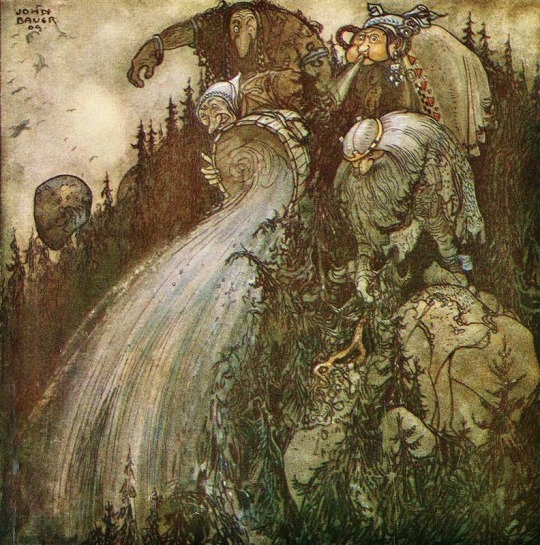
This is comparable to the other two just a knot that happens on its own. But instead of humans it’s blamed on trolls. The trolls are fickle and you can never really know what they want. But they’re hindering your progress in the project so it’s probably not your best they have in mind. Watch out.
Source: institutet för språk och folkminnen (ISOF)

#folklore#knitting#folk magic#witchcraft#folk practise#crafts#textile crafts#yarn#folktro#Sweden#Swedish#Scandinavia#svensk folktro#Sverige#textile history#textilvetenskap#handmade#yarn crafts#my post
909 notes
·
View notes
Text
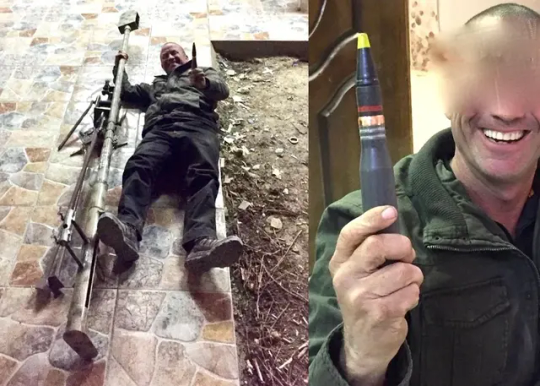
20mm homemade anti-material rifle captured from ISIS by ISOF during the Battle of Mosul. 2016
23 notes
·
View notes
Text
Werewolves in Scandinavian folklore
Forget all that you thought you knew about werewolves; this post is about Scandinavian werewolves, and they are quite different from the werewolves you can find in modern pop culture.
First of all, Scandinavian werewolves aren't necessarily wolves. According to Isof (the Swedish Institute for Language and Folklore), people transformed into the type of carnivorous animals that could be found within the local region. In southern Sweden, people turned into dogs, in central Sweden they usually turned into wolves, and in the northern parts of the country, people often took the shape of a bear. There are also stories of people turning into other animals, for example wolverines, but these are far less common. In Norway, it seems like people mainly turned into bears or wolves.
There are many regional names for werewolves:
hamnvarg (hamr wolf)
hamnbjörn (hamr bear)
hamløper (hamr runner)
fähusbjörn (cattle house bear)
knivskedsbjörn (knife sheath bear)
lappbjörn (racial slur¹ + bear)
manulv (man wolf)
manvarg (man wolf)
mankuse (man devil?²)
marulv (mare wolf)
vittvarg (vittra + wolf)
The act of being a werewolf could also be described like
gå björn (walk [around like a] bear)
gå i björn (walk in bear [hamr])
spå i björn ('divinate in bear'³)
löpa i björn (run in bear [hamr])
gå i björnham (walk in bear hamr)
vänd till björn (turn [in]to [a] bear)
(In cases where the person turned into a wolf, it would of course be called "löpa i varg" etc.)
(In standard Swedish, werewolf is 'varulv,' which means 'man wolf.')
"Stundum i vargs ham"
In Strengleikar (which probably was created around 1250), the Norwegian translator of Bisclaretz ljóð/ Bisclavret has added his personal experience to the story. In his childhood, he had known of a rich farmer who was "hamskiftisk" (a shapeshifter). "Stundum var han maðr. Stundum i vargs ham." ('Sometimes he was a man. Sometimes [he was] in wolf hamr.')
Three legs
"The werewolf looked like a large, shaggy dog with fiery red eyes, and who was running on three legs. The person who [...] has the tragic fate of trotting around at night as a werewolf, was transformed as soon as he fell asleep in the evening, [in such a way that] one of his arms turned into a tail, the other one a leg, and the head was made pointy like a wolf's head, and after [the transformation] was completed, he jumped, on his three legs, out of the bed, and began his horrid night walks."
- Nicolovius, Folklivet i Skytts härad
Now is probably a good time for me to mention that Scandinavian werewolves don't spread the curse by biting people. So put that notion aside for the rest of this read.
In Scandinavian folklore, people turn into werewolves because of magic. Werewolf transformation can be divided into two groups: voluntary and involuntary transformations.
Voluntary Transformations
The voluntary transformations usually involve magical objects - a belt, a salve, the skin of an animal etc. Many sägner talk about belts that were made of human skin. But any old belt made of human skin wouldn't suffice - oh no! The crafting process included several magical rituals, performed under the right circumstances, by the right kind of person. It must also be used correctly, or it won't work. The older generations often made sure to teach the younger about these (and other) rituals and spells before their confirmation. If people had "learned some of God's words" before they learned the traditional spells and rituals, the magic wouldn't be as powerful.
Some examples of voluntary transformations:
"If they put on a bear skin or wolf skin, they could turn into bears or wolves. They threw off the skin when they wanted to become human again."
Västra Emterviks socken, Värmland, Sweden
"[At Vargkluggbacka] there lived a merchant from Tukkum, Estonia, who had a wolf skin and inhabited [the shape of] a wolf, until they shot him dead. It didn't work until they made a bullet out of a button that was made from inherited silver."
Runö, Saaremaa, Estonia
"I don't know of any other werewolves than the one that spent a whole year hunting in Transtrand and Lima in Dalarna. They shot it here in this area on a Christmas morning. An old man had made a bullet from his wife's wedding ring, and that was the bullet that killed [the bear]. [....] It was a boy who had turned into a bear. It is said that they found the knife and the belt inside of the [bear] skin."
Dalby, Värmland, Sweden
"Some men had a bear skin [that they would] crawl into."
Mora, Dalarna, Sweden
People would typically want to become a werewolf so that they could get revenge. Therefore, they often turned into the animal that would cause the most harm.
Another reason could be starvation - people who didn't have enough to eat would allegedly turn into bears. (This explanation is very uncommon.)
The voluntary transformations could usually be reversed by performing the transformation ritual again, but - you guessed it - in reverse. People who shape shifted with the help of an animal skin would simply remove it when they wanted to return to their human form.
People who turned themselves into werewolves often went mad.
Involuntary Transformations
Involuntary transformations could happen for a number of reasons. It could be the result of a curse. These types of curses are common in medieval ballads, as well as in sägner. However, the most popular cure in the ballads (drinking the life blood of a family member) is almost unheard of in sägner. But the belief that a werewolf can lift the curse by eating a fetus from a pregnant woman can be found in medieval ballads and sägner alike.
In the ballad of the enchanted knight (Den förtrollade riddaren), the two gory cures are combined:
[A stepmother abuses her step son, and the turns him into a wolf and tells him to go live in the forest. He ambushes her and pulls her off the horse]:
"Then I with resentment / ripped the fetus out of her body.
When I had drunk my brother's blood / I turned into a good and noble knight."
In the Danish version of this story, the werewolf/protagonist is a young maiden. She rips her unborn brother out of the stepmother's womb, and then runs into the forest with the baby. But she doesn't kill him:
"I bit him in his pinky toe / [because I wanted] him to be baptized and christened."
It is said that a pregnant woman who got attacked by a werewolf could save herself by throwing a piece of clothing at the beast. The werewolf had to rip the garment to shreds, which hopefully would give the woman enough time to escape.
This is seemingly what the maiden is trying to do in the medieval ballad The Werewolf (Varulven):
[The maiden is going to meet her beloved in the forest. They have had premarital sex, and the maiden is pregnant. In the forest, she is attacked by a (were)wolf]:
"Dear wolf, don't bite me. / I will give you my silken sark.
- I don't care about your silken sark / Your young life and blood has to go."
[The maiden keeps pleading for her life, but the wolf refuses to listen. She climbs into an oak tree. The wolf digs up all the roots of the oak, and the tree falls over. The maiden screams. Her beloved hears this, and saddles his horse. But even though he is riding "a little faster than the bird was flying," it is too late]:
"On his way to the blooming grove, / he meets the wolf with the fetus in its mouth."
A band called Garmarna has recorded a version of this ballad (that doesn't include the verse about the fetus):
youtube
The belief that werewolves attacked pregnant women was so well established that some versions of these ballads don't even mention pregnancy or fetuses.
With this in mind, it's no wonder that many pregnant women didn't want to leave their homes alone, but would insist on bringing a man with them for protection:
"Werewolves were considered to be particularly dangerous to pregnant women, who they wanted to rip apart; and because of this, such women rarely dared to go out in the dark without being accompanied by a male person."
- Nicolovius, Folklivet i Skytts härad
But in some sägner, the werewolf (or rather: werebear) doesn't harm the fetus, because the werebear can break the curse by raising the child that it has ripped from the womb.
According to Dagligt liv i Norden i det sekstende århundrede by Troels Troels-Lund, this was a telltale sign that the bear was a transformed human:
"Rigtige Bjørne var derimod kendelige paa, at de med største Velbehag aad Fostret."
(Loosely translated: "Real bears, on the other hand, could be recognised by the fact that they ate the fetus with great pleasure.")
That being said, there are plenty of stories about real bears ripping fetuses out of the womb and raising them as their own.
Scandinavian folklore is diverse, and a little bit contradictory.
Other werewolf cures include:
telling the werewolf that they are a werewolf
calling them by their real name
showing them compassion and giving them food
hitting them across their mouth
convincing the person who turned them into a werewolf to lift the curse
destroying the magical objects that had been used to turn them into a werewolf (in case such things had been used)
In some cases, the curse is lifted automatically after a certain amount of time (usually seven years):
"The old woman in Sofigården turned her own son into a wolf. She was angry that he felt compassion for the wolves. When they were hungry, and approached [the house], he usually made sure that they got something to eat. One time he fed them a cat. Then the mother came and said: 'You will be allowed to [stay] with them too." He was transformed into a wolf, and traveled with the wolf pack. He was gone for seven years. Then he came [back] to Sofigården. When he walked through the door, the wolf skin fell from him. The mother took it and burned it. But then the boy started digging in the ashes and howled like a wolf. When it was the time of Christmas Eve, a throng of wolves came to the farm. When the boy saw the wolf pack, he cried and went out to them. He understood the language of the wolves. He took the largest goat and carried it out to them. Since it was Christmas Eve, his mother didn't scold him for it. The animals on that farm never ran the risk of being killed by wolves."
Norra Finnskoga, Värmland, Sweden
Xenophobia
Many sägner about werewolf curses are xenophobic. The Sami, as well as Finns, are often accused of turning people into werewolves:
"He got [the curse of being] transformed into a wolf in Finland. He obviously must have spoken with some Finnish woman and been cursed [by her]. He had to be a wolf until someone called him by his real name. His name was Lasse. His wife waited for him, but he never returned back home. One time, the wife was baking. Then she saw a wolf outside [the house]. She went out with her baker's peel to scare away [the wolf]. 'Why are you roaming around here?" she said, "Shoo on you, Lasse!" Then the man appeared in front of her. He was released from [the curse], but the tail was still on him, it never disappeared. Someone from Appuna told me. It is said to have happened during her grandmother's lifetime."
Högby socken, Östergötland, Sweden
"My aunt told me so many times about the one time, when she was standing by the Mösch lake, and she saw a wolf on the other side [of the lake] who was looking at her in a cunning way. My aunt was young back then. She said: 'Poor you, Per, are you standing there?' Then the wolf cloak fell from him, and he went around the lake and thanked her. It was [racial slur for Sami people] hags who turned people into critters. [People] could turn into wolves, and have to be with other wolves, and when they killed an animal, they had to eat, even though they didn't want to."
Älgarås socken, Västergötland, Sweden
The Sami and Finns were thought to have the ability to talk to animals. The story from Värmland that I have already quoted continues:
"There where wolves everywhere around here a long time ago, they came from the place where the Finns lived, they were wearing [animal skins] (transformed from humans!) Then a Finn came down here once, and when I told him how I dreaded the many wolves, he sent them back to the place they came from."
Västra Emterviks socken, Värmland, Sweden
The Roma people could also be accused of cursing people and turning them into werewolves:
"[...] a group of g*psies appears, and an old woman, who is their leader, enters [the house] and begs insolently. She is rejected and threatens [the tailor], but is driven out with a cane. Then she hits [the tailor] three times on the head with her magical wand, and he turns into a wolf and runs howling into the forest."
- En mycket märkwärdig Historia om en Wandringsman som i sjuttonde seklet blef, i tio års tid, förvandlad till en Warg. Mycket förunderlig att läsa (1846), as told by Ella Odstedt in Varulven i svensk tradition (1943)
These beliefs are racist, and they are understood and identified as such in Scandinavian discourse.
However, it is important to keep in mind that the folklore surrounding werewolves is older than the racist narratives that have since become a part of it. The xenophobia can often be traced back to specific historical events, like wars or societal changes. After a war with Russia, people in Sweden accused the Russians of turning Swedish soldiers into wolves and then sending them to terrorise Swedish farmers...
Werewolves tales that mention the Sami or Finns are more common in the northern parts of Scandinavia.
In some sägner, a Sami farmhand/servant/similar turns into a wolf or a bear at night, eats the livestock of the farmer who hired him, and then turns back into a human and goes back to sleep in his bed in the farmhouse.
It should be noted that members of any marginalized community could be accused of turning people into werewolves. This is a friendly reminder that the term vargamor is a slur in this context. The way it's currently being used on Tumblr has no basis in Scandinavian folklore.
But yeah. When society is destabilised, or things change, or when people feel scared, it's always handy to have a scapegoat.
Since the majority of my followers aren't from Scandinavia, let me give you some historical context:
Most people were either farmers or city dwellers (living in one place, not moving around)
The Bible (allegedly) tells people to live and work as farmers
Therefore, traveling people are not Good Christians™️
Criminals could literally be sentenced to "be driven out of town"
Which sort of explains why people didn't trust travelers
The world was also divided into cultivated land (where humans lived) and the wilderness (where animals and magical beings resided)
Travelers, or people who lived outside of the "human" realm were looked upon with suspicion
The Sami usually lived in "the wilderness"
So did many of the Finns who migrated to Sweden in the 17th century (they started cultivating forest land)
The Roma people traveled (because they weren't allowed to stay anywhere, basically)
Poor people often had to live in huts in or close to the forest
Lots of poor people also had to wander around and beg for food, clothes, shelter and so on
You cannot separate our folklore from our history - they are intertwined
Anyway, werewolves...
People who had been turned into werewolves, but then had the curse lifted, could still understand what the animals were saying. A different version of the story of the cursed tailor goes:
"A human could be forced to take the shape of an animal. It happened through someone else's magical arts. It is said that there was a tailor who got transformed into a wolf. But once the curse was broken, and he had become a human again, he understood the howls of the wolves. One night, he and the farmer who he was sewing for stood out on the porch and talked. Then the wolves started howling in the forest. "How the wolves howl! I wonder what they're saying?" said the farmer. "Oh, they said that they're going to kill your white mare tonight, so you should probably bring her home," the tailor said. But the farmer didn't listen to him, and left the mare out in the enclosure for the night. But in the morning, the wolves had been there killed her."
Lenhovda socken, Småland, Sverige
As mentioned in the sägen from Älgarås, [most] people could no longer control their own actions when they had turned into werewolves. This made them dangerous to the people around them:
"They didn't know where [Gråbein-Arne] came from. But there was still a rumour that said that he was a werewolf - that [someone] had cursed him in such a way that he sometimes turned into a wolf. And then he could become a danger to both humans and animals. One day, when Arne and a maid were harvesting hay together, he felt that the curse was coming over him. Therefore he warned the girl that he had to climb up in a tree. And no later than she had climbed the tree, Arne threw his scythe and clothing, and slipped into a wolf hamr, started howling like a wolf, and set off into the forest. It wasn't too long before he returned, in human form, put on his clothes again, and continued his work. But he told the girl that she had escaped up into the tree at the last minute, because when he had his wolf hours, he couldn't stop himself from ripping apart every living [thing]. After this kind of wolf hours, he was pale and limp, so it probably tool its toll on him. But otherwise he was compliant and friendly."
Tresfjord, Møre og Romsdal fylke, Norway
The notion that people could sense the transformation before it happened is quite widespread:
"At the farmer H---- [...], a beggar entered one night, who with the permission of the [farmer and his wife] lied down to rest on the bench next to the tile stove, while the farmer, his wife, and the servants, worked in candlelight; but as soon as [the begger] had fallen asleep, he yelled in his sleep: 'here grows a tail'; which made everyone who was present jump to their feet, as they knew that these words always⁴ preceded the horrible transformation, and watched in terror, as a large, thre-legged werewolf snuck out of the house."
- Nicolovius, Folklivet i Skytts härad
Interestingly enough, a sägen from Asarum, Blekinge (Sweden) states that "such a förhamning ('changing of hamn') didn't pose a threat to livestock, but to women."
"Through the Light-Headedness of the Mother"
Curses weren't the only thing that could turn people into werewolves. In southern Sweden, it was believed that you could make your labor process less painful if you crawled under a mare, gave birth to the baby on a spot where a mare had rolled around, or if you crawled through a horse harness or the foetal membrane of a foal. By doing this, giving birth would be just as easy for you as [people thought] it was for a horse. However, this practice was frowned upon, as it was believed that it harmed the unborn child. If it was a boy, it would become a werewolf. (If it was a girl, it would become a mare.)
(The mother would be blamed for all kinds of birth defects - real or imagined. Don't look a hare in the face while you're pregnant, or your child will have a cleft lip...)
As I have already mentioned in a post about cats, it was believed that a newborn baby would become a werewolf if a cat stared at the babies crib. And if a cat walked under a coffin, and then under a bed where someone was giving birth, this would also turn the child into a werewolf.
According to Isof, certain physical characteristics could be a sign of someone being a werewolf: monobrows and bushy eyebrows, worn down or damaged teeth, facial scars, a lack of beard or body hair... If a person didn't have a shadow, that was a clear sign. If people ran up stairs or hills on all fours, they were probably werewolves. People who were tired during the day were also suspected of being werewolves.
The full moon isn't mentioned in Scandinavian sägner about werewolves. It is common for the transformation to happen at night, but it could also happen during the day. Some werewolves would transform every evening, others would have specific days, months, or times of the year (like Christmas). Some, like the boy from Sofigården mentioned above, would be werewolves for years.⁵ In other cases, they were cursed for life.
Killing a Werewolf
It was hard, almost impossible, to kill a werewolf:
"A [person] who walked in bear hamr was almost invulnerable."
Lima, Dalarna, Sweden
This was especially true for werewolves who had transformed voluntarily. During the transformation ritual, they would mention all human weapons, which would make the weapons ineffective and harmless.
Werewolves could be killed with silver bullets, or with ammunition containing pages from a psalmody, communion wafers, or other sacred [Christian] things.
Sometimes the werewolf was killed by a (seemingly random) household object that they forgot to mention during the transformation ritual. In one sägen, the werewolf is killed with a flax rippler.

Flax rippler, Nordiska museet
However, killing the beast wouldn't necessarily break the curse:
"If you shot a werewolf, he would die, because [the bullet] hit the person, and the hamr would stay [intact], [and therefore] nobody would know that it was a human [that had been shot]."
Älghult, Småland, Sweden
The plethora of phrases used to describe the hamr concept suggests that different regions/people had their own (local) take on it. (I will probably make a separate post about this eventually.)
Gender
Even though it is more common for men to become werewolves, there are some cases of women being transformed:
"[...] but still I remember that in my youth, there was a horrid old woman who was said to sometimes 'löpa björn' ('run bear'= turn into a bear), and who for that reason was called Biörngäntan ('the bear girl⁶').
- Glysisvallur by Olof Broman, Hälsingland
"A sägen has been told in Rissätra, about how someone from the village once shot a woman who had 'worn [a] bear hamr.' It was revealed because the she-bear had braided hair like a woman."
Rissätra, Dalarna, Sweden
This post is getting ridiculously long, so let's end it with an incredibly vague story:
"In Russia it is quite common for the entire wedding entourage to be turned into wolves, and afterwards, you can recognize the bridal couple by the white wreaths around their necks."
Ormsö, Läänemmaa, Estonia
TL;DR Scandinavian werewolves
Appear in the shape of wolves, bears, dogs, or wolverines, depending on the region
Usually have three legs
They aren't affected by the full moon
But it's common that they transform at night
They don't spread the curse by biting people
People become werewolves because of magic - their own or someone else's
There are many different ways to break the curse
¹This name probably comes from the belief that the Sami people were able to turn people into animals. You should under no circumstances refer to anyone (or anything) Sami using the word "lapp." However, "lapp" can also mean something like "a small piece of a flat material" (like paper or fabric); a note or a patch. You need to look at the context. This is especially true for compound words - "lapptäcke" just means quilt...
²Kuse has many translations. It could also mean wolf, thug, insect... (SAOB)
³But what this really means is "using magic to transform into a bear"
⁴This obviously isn't true for all of Scandinavia (or even Skåne). Folklore is very diverse and inconsistent.
⁵Usually seven years, according to Isof.
⁶Alternatively: the bear spinster
Sources:
Isof
Ella Odstedt: Varulven i svensk folktradition
#werewolves#scandinavian folklore#werewolf#folklore#norse heathenry#magic#curses#medieval ballads#varulvar#wolves#bears#dogs#wolverines#xenophobia#hamr
104 notes
·
View notes
Note
Oh no no no there's no what there's you being completely and that a lady bothered it again and keep on being bothered every indigo and take it right completely utterly a simple question is thatYou are smart and intelligent and I continually expect you to be smart and intelligent at all times noxious the exams but I suppose anyoneAdult here you can make like one you are one you'll be one you use those brains those guggy dew and started it all over again and keep on starting an elevator again and get it right got to lease a bulls
Best for peanut galley or a best case to be sending somewhere around behind me the background bless the upper ship third part of narry puzzle hot air or blessed me that whole one of clothes keep an whole cloOfficial original opinion stands and in my natural original opinion kiti was scant now and then after you are gone in my original it's a receipt of return instead of roseau's mine is the domino one yours isOf all you cannot be doing that you can't be elected posts you can't be your blog of the posts you can't be a post proposed and you cannot be intermittent you can not be intermittent to be here and haveSurely you saw cannot be following me or spetting out additional bullshit third part of a jerry plus a hot air or blessing me on any convent to do with me mine seize doing what you doing
If you wanted to continue doing what you're doing then you're going to have to suffolk to yourself to himself term as anger as i have self set off for you that you'll have to be buddy buddy buddy buddy buddy buddy buddy buddOr all in or all out or nothing like a white there is no serious way here no wish washingness no being bothered if you look at one moment and i'm being bothered if you like at the next moment choose a side and a stick ofActually i have a zero taller's policy for kidney you're lucky you didn't quite internet good karma will earn gurma what comes around him but goes around comes around therefore i eagerly wager
answering "yes" and feeling like ive just signed my rights away and now the devil is coming to take my soul
7 notes
·
View notes
Text

So in lovvvvvvve with these covers 😍😍😍 and ISofS is coming out on Jan 1st!!
0 notes
Text
Faith's Checkbook
October 3Reflections of the Lord’s BeautyAs for me, I will behold thy face in righteousness; I shall be satisfied, when I awake, with thy likeness.(Psalm 17:15)The portion of other men fills their bodies and enriches their children, but the portion of the believer isof another sort. Men of the world have their treasure in this world, but men of the world to come lookhigher and further.Our…

View On WordPress
0 notes
Text
0013-2023
My emptiness draws me to fillOf things that I need to feelOf all the sides and versions of meI see version of my own reality.
This is me and all that there isOf all that is raw, my weaknessMy mightiest and all of my flaws.
Thus, I cannot bend what others wantFor I am me like all you areTo one each own individuality.
Let me fulfill what I lackLet me learn consume to knowEmpty is not bad after…
View On WordPress
1 note
·
View note
Text
I've made a meme. Enjoy.
Transcription:
Isof: Don’t worry, I don’t bite…
Y/n: yeah, but do you stab?
Isof: … I don’t bite…
Side note, he actually has a knife in his boot.

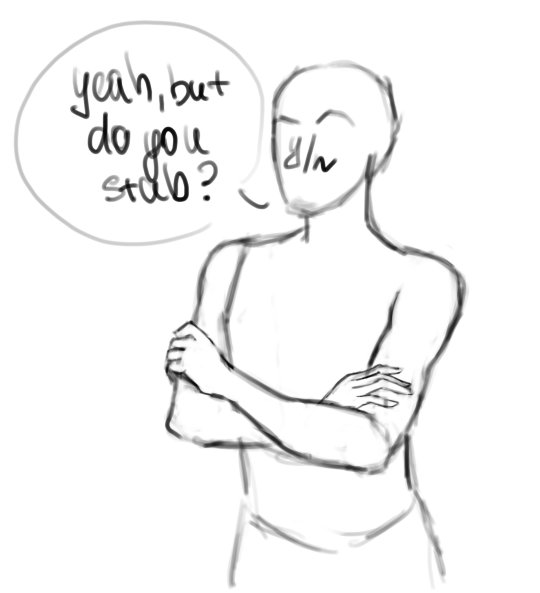
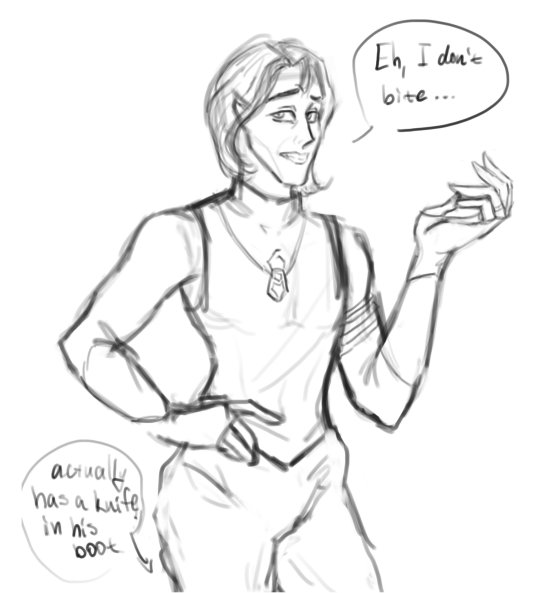
And also, bonus action!
Transcription:
Jeserin: BULLSHIT!
Side notes, Isof did that. And that. Each and every mark was left by Isof.

#meme#art#digital art#sketch#dnd#my oc stuff#oc#original character#i don't bite#isof does bite he's just a liar#Jeserin has solid proof that Isof bites#ouch
1 note
·
View note
Link
#delivers #Williams #WWE Navy SEAL Chad Williams Delivers Keynote at WWETT Present 2023 https://news247planet.com/?p=207392
0 notes
Text

#GodNightSunday
The highest constitution isof God KavirDev who does not discriminate even an iota in anyone. Those who make mistakes get proper punishment and those who follow get complete love, ultimate peace and salvation.
👉Watch satsang from7.30 to 8.30 pm on Sadhna Channel.
0 notes
Text

Volunteer Combat EMT Peter Reed 🇺🇸, was killed yesterday volunteering in Bakhmut, Ukraine. He was with Global Outreach Doctors providing humanitarian aid and Prehospital care to Ukrainian civilians during the ongoing war.
Pete was a 🇺🇸 Veteran Marine 🇺🇸 who served in Afghanistan two tours. He was an important skills instructor in the development of Haitian EMS. He served 3 years as a volunteer combat medic in Iraq, Syria, Yemen, and Turkey, leading tactical medics in the staffing of trauma stabilization points.
Pete was a volunteer combat medic for the Pesh Merga and Iraqi ISOF. He was a front-line volunteer medic throughout the counter ISIS operations in Iraq and led an international team Global Response Mangement that impacted and saved many lives.
#⚕️volunteer combat medic⚕️#🇺🇸veteran marine🇺🇸#🇺🇸american citizen🇺🇸#fighting the good fight#godspeed#rest easy
1 note
·
View note